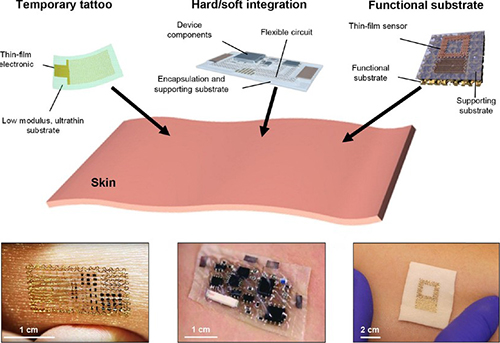Lab-on-skin is the latest concept to join the lab-on-a-chip, lab-in-a-needle, and lab-on-paper field, as researchers continue to seek ways to miniaturize medical laboratory tests
Move over, lab-on-a-chip and lab-on-paper. There’s a new diagnostic technology in research labs that is gaining credibility. It is called lab-on-skin technology and some scientists are quite excited about how it might be used for a variety of clinical purposes.
A recent story published in ACS Nano titled, “Lab-on-Skin: A Review of Flexible and Stretchable Electronics for Wearable Health Monitoring,” reviews the latest advancements in lab-on-skin technology. It provides an overview of different research initiatives incorporating lab-on-skin technologies.
From telehealth to precision medicine to point-of-care mobile devices, anatomic pathologist and clinical laboratories are about to be challenged with new diagnostic technologies. These technologies are intended to streamline the workflow between physicians and medical laboratories while improving access to patient data and medical laboratory test results.
Of all the mobile devices designed to support medical care, no technology may have more potential to change the pathology profession than nanotechnology-based diagnostic devices. Whether lab-on-a-chip, lab-in-a-needle, or lab-on-paper, these miniature laboratories are so small dozens can be carried in a pocket.
Most importantly, for certain diagnostic tests, some of these devices being developed hope to deliver full-size-lab quality results accurately and inexpensively, even in rural regions and areas with little or no resources, such as electricity or water. (See Dark Daily, “Lab-on-a-Chip Diagnostics: When Will Clinical Laboratories See the Revolution?” September 9, 2016.)
Now, researchers have demonstrated that even biomarkers within human skin can be tested by medical wearable devices. “Lab-on-skin” has entered the pathology vernacular.
Lab-on-Skin Constantly Measures Physiological Data
According to ACS Nano, lab-on-skin devices are small electronic patches worn directly on the skin that noninvasively measure a variety of physiological data. These flexible gadgets can interpret information including:
- body temperature;
- blood oxygenation;
- hydration;
- blood pressure;
- glucose;
- potassium;
- sodium; and,
- lactate and pH levels in individuals.
The devices may also be used for wound care, prosthetics and rehabilitation, as well as for optogenetics and human-machine interfaces (HMI).

The image above from the ACS Nano article demonstrates various lab-on-skin devices, including: an NFC tattoo with a bare die chip mounted on an acrylic adhesive film; a soft radio sensor with commercial chips encapsulated in a fluid/ecoflex package; and, a sweat sensor on silicone foam. Each of these devices could be capable of delivering actionable diagnostic data to anatomic pathologists and clinical laboratories. (Image copyright: ACS Nano.)
Lab-on-skin technology can be utilized to read electrophysiological signals typically measured by electrodes placed on various parts of the body, such as:
- electrocardiography (ECG or EKG);
- electroencephalography (EEG); and,
- electromyography.
The direct connection between the patches and the skin allows for continuous and precise data collection without the threat of drying out that comes with traditional electrodes.
Nanotechnology Driving Clinical Laboratory Diagnostic Applications
Because it is the largest organ in the body, skin provides a perfect pathway to convey biological information originating from various parts of the body, such as inner organs, muscles, blood vessels, and the dermis and epidermis.
The ACS Nano article discusses advancements in the designs and materials used for lab-on-skin patches. In addition to the term “lab-on-skin,” these devices may also be referred to as electronic skin, epidermal electronics, and electronic tattoos. They have untapped potential in a variety of clinical applications, including:
- cardiology;
- dermatology;
- electrophysiology; and,
- sweat diagnostics.
For example, researchers at the University of Illinois at Urbana-Champaign have created an epidermal nanotechnology device that utilizes sensors and wireless interfaces to measure ultraviolet (UV) exposure, a risk factor for skin cancers.
“Our goal with this research is to establish a set of foundational materials and device designs for systems that can improve health outcomes by providing information on UV exposure,” John A. Rogers, PhD, and Professor of Materials Science and Engineering and Professor of Chemistry told Nanowerk Spotlight.
Nanotechnology employs extremely small particles performed at the nanoscale (about 1 to 100 nanometers). This field is emerging as a vital element behind cutting-edge innovations in medicine and healthcare.
“We developed new chemistries that yield color changes that quantitatively relate to total exposure dose, separately in both the UV-A and UV-B regions of the solar spectrum,” explained Rogers. “Our formulations have the additional advantage that they provide soft, low modulus mechanics to enhance comfort and biocompatibility with the skin surface.”
Mini-Laboratory Devices Could Push Pathology Data to Clinical Laboratories
The combination of using lab-on-skin devices with nanotechnology can provide researchers and medical professionals a multifunctional and valuable tool for health monitoring and the diagnosis of diseases. However, more research and clinical studies are needed to establish the validity of using lab-on-skin devices in healthcare applications.
Nevertheless, clinical laboratories and pathology groups will be handling more data in the future, generated by these miniature laboratory devices. Their usefulness, especially in challenging healthcare environments, is only beginning to be fully discovered.
—JP Schlingman
Related Information:
Lab-on-Skin: Nanotechnology Electronics for Wearable Health Monitoring
Stick-on Epidermal Electronics Tattoo to Measure UV Exposure
Nanotechnology in Healthcare (Part 1: Fitness Monitoring, Diagnostics and Prevention)
Nanotechnology in Healthcare (Part 2: Nanomedicine Therapy)
Breathable, Wearable Electronics on Skin for Long-term Health Monitoring
Nano-chip Promises to Heal Organs at a Touch
IBM and Mount Sinai Researchers Develop Innovative Medical Lab-on-a-Chip Solution
Lab-on-a-Chip Diagnostics: When Will Clinical Laboratories See the Revolution?



